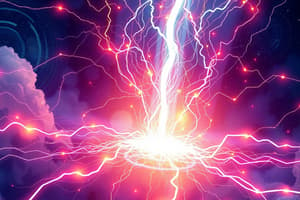Podcast
Questions and Answers
What is electric current?
What is electric current?
Orderly flow of electrons in a conductor per unit time (or) rate of flow of charges in a conductor.
What is a switch?
What is a switch?
Conducting link between cell and bulb.
What is an electric circuit?
What is an electric circuit?
Continuous and closed path of an electric current.
What symbol is used to represent electric current?
What symbol is used to represent electric current?
What symbol is used to represent electric charge?
What symbol is used to represent electric charge?
What brings the electrons in order?
What brings the electrons in order?
What is the formula to find the electric current in a conductor?
What is the formula to find the electric current in a conductor?
What is the SI unit of electric charge?
What is the SI unit of electric charge?
What is the SI unit of electric current?
What is the SI unit of electric current?
What instrument is used to measure electric current?
What instrument is used to measure electric current?
Define one ampere.
Define one ampere.
How is an ammeter connected in a circuit?
How is an ammeter connected in a circuit?
What is the conventional direction of electric current?
What is the conventional direction of electric current?
What are the two types of electric charges?
What are the two types of electric charges?
What is the number of negative electric charge in a circuit?
What is the number of negative electric charge in a circuit?
What is the formula to find electric charge if the total number of charges is given?
What is the formula to find electric charge if the total number of charges is given?
How many charge carriers constitute one coulomb of charges?
How many charge carriers constitute one coulomb of charges?
What is the range of an ammeter?
What is the range of an ammeter?
What is electric potential?
What is electric potential?
What is the formula to find Electric Potential?
What is the formula to find Electric Potential?
Which charge has higher potential?
Which charge has higher potential?
What is the SI unit of potential difference?
What is the SI unit of potential difference?
What instrument is used to measure potential difference?
What instrument is used to measure potential difference?
How is a voltmeter connected in a circuit?
How is a voltmeter connected in a circuit?
What is the range of a voltmeter?
What is the range of a voltmeter?
Flashcards are hidden until you start studying
Study Notes
Electric Current
- Electric current refers to the orderly flow of electrons in a conductor over time.
- It is quantified as the rate of flow of electric charges through a conductor.
Switch
- A switch acts as a conducting link between the cell and the bulb, enabling control over the circuit.
Electric Circuit
- An electric circuit is a continuous and closed path that allows electric current to flow.
Symbols in Electricity
- The symbol "I" represents electric current.
- The symbol "Q" represents electric charge.
Battery Function
- A battery is responsible for bringing electrons into an organized flow in a circuit.
Current Calculation
- Electric current (I) can be calculated using the formula: I = Q/t, where Q is the charge and t is time.
Units of Measurement
- The SI unit of electric charge is the coulomb (C).
- The SI unit of electric current is the ampere (A).
Measuring Instruments
- An ammeter is an instrument used to measure electric current.
- An ammeter must be connected in series within a circuit to measure current accurately.
Definition of Ampere
- One ampere is defined as the flow of one coulomb of charge per second.
Electric Charge Types
- There are two types of electric charges: positive and negative.
Charge Carriers
- The charge of a single negative electric charge is -1.6 × 10⁻¹⁹ C.
- To find total electric charge (Q) based on the number of charges (n), use the formula Q = ne, with e being -1.6 × 10⁻¹⁹.
- One coulomb of charge is constituted by approximately 6 × 10¹⁸ charge carriers.
Electric Potential
- Electric potential is the work needed to move a unit charge from one point to another within an electric field.
- The formula for electric potential (V) is V = W/Q, where W is work done and Q is charge.
Charge Potential
- Positive charges are considered to have a higher potential compared to negative charges.
Potential Difference Measurement
- The SI unit of potential difference is joule/coulomb, commonly referred to as a volt (V).
- A voltmeter measures potential difference and is connected in parallel to the circuit for accurate readings.
Instrument Ranges
- The typical range for an ammeter is 2 A.
- The range for a voltmeter is typically 10 V, allowing for a measurement of potential difference between points in a circuit.
Studying That Suits You
Use AI to generate personalized quizzes and flashcards to suit your learning preferences.




